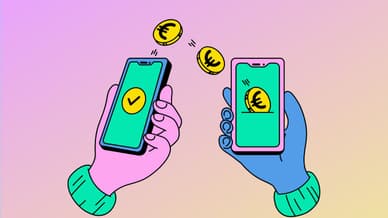Digital Payment Services in 2024: Key Trends and Payment Methods

The post-pandemic shopping environment continues to be shaped around digital payment services. Whether you are a business owner looking to implement modern solutions or you are introducing a startup project in the financial sphere, knowing the latest developments is essential. This will ensure your growth and allow you to deal effectively with competition.
What global trends in the digital payment industry in 2024 should we pay attention to and prepare for? We’ve defined primary directions and coming innovative changes that have already established roots but still have massive room for an impactful raise.
WHAT ARE DIGITAL PAYMENTS?
Digital transactions, also known as electronic payments, are more widely used than ever. A digital transaction is when one party transfers money to another party using specialized technologies. Options include mobile apps and wallets.
ELECTRONIC PAYMENT SYSTEMS
Electronic payment systems allow individuals to send money digitally in the shortest terms. With interest in online shopping continuing to increase, electronic payment technologies are more important than ever. Some of the electronic payment methods include:
- eChecks;
- Bank transfers;
- BNPL (buy now, pay later) services.
MOBILE PAYMENT APPS
Mobile payment apps are designed for quick funds transferring with the help of smartphones or tablets. Peer-to-peer apps are top-rated among users, with transaction volumes reaching over a trillion dollars. The widely used apps include:
- Venmo;
- Cash App;
- Zelle;
- PayPal;
- Google Pay.
MOBILE WALLETS
A mobile wallet is designed to store your credit card or other payment-related information. More people these days switch to paying with their mobile wallets instead of credit cards because of the convenience of always having your phone with you. Modern mobile wallets include:
- Google Pay;
- Apple Pay;
- Samsung Pay;
- PayPal.
CONTACTLESS PAYMENTS
Contactless payments rely on the use of near-field communication or radio-frequency identification. To pay, you simply need to bring your credit card or phone to a point-of-sale terminal. The contactless options include:
- Mobile wallets (Apple Pay, Google Pay);
- Debit and credit cards with NFC technology.
Now, let’s move to the digital payment industry trends themselves.
Growing Adoption of Mobile Payments

The rapid growth of mobile technologies turned traditional communication gadgets into unique and universal tools that replaced dozens of other devices. Unsurprisingly, mobile payment trends also found their place here, helping us forget about cash and banking cards and saving pockets from large leather wallets. This became especially vital during the active phases of the COVID-19 pandemic when contactless payments became a must-have option.
This trend became possible with the remarkable speed of transactions made via mobile phones and their high security level. Now, everyone can have multiple bank accounts, diverse credit/debit cards, and dozens of currencies in a gadget that is always at hand. Of course, merchants felt the switch too and now widely adopt it in both their online and offline stores, with small businesses being at the forefront.
While all these trends in mobile payments look too obvious, predicted volume growth is still crucial. Research and Markets expect global mobile payment volume growth from $1.7 billion in 2021 to more than $6 billion in 2027. The real CAGR can be even higher than the predicted 22.4%, so businesses should keep those numbers in mind and keep up with the trend.
Rise of Cryptocurrencies

It’s impossible to talk about digital financial trends without mentioning cryptocurrencies. Virtual coins and decentralized currencies passed their recognition stage and fully entered the global economy as a growing alternative. With the digital nature of its roots, cryptocurrencies are actively widening their adoption geography in the online payments sector. In simple words, more and more companies, even small ones, can offer their clients the ability to pay for goods and services with digital wallets.
Of course, the lion’s share of the overall crypto payments belongs to Bitcoin, Ethereum, and Tether, with this trio holding almost 3/4 of the total crypto capitalization. It means that access to nearly $850 billion can be opened by adding those three cryptocurrencies as one of the payment methods—not the option a wise merchant would lose.
Nonetheless, cryptos are still in the shade of complete understanding and can potentially increase their volume and impact on the global financial services industry. Many people still perceive virtual coins as investing or diversifying features free of direct political influence, while others fear huge floating rates. However, blockchain gives cryptocurrencies instant speed and perfect transaction protection, with the latter being among the most discussed trends in payment processing in the coming years.
Enhanced Security Measures

Despite reviewing cryptocurrencies as one of the best instances of safety, payment processing industry trends are still mostly related to more traditional security measures. The talk is about encryption level, compliance with PCI DSS, AVS, and 3D authentication, which are constantly being upgraded and regularly updated.
While most people think that fraud is mostly related to users’ inattentiveness, companies know that they should do their best to secure every possible aspect and save this “convenient” opinion. If more clients see problems with their financial safety, the reverse trend of digital payments can send the whole online sales sector into the gutter.
Since global online payment trends are moving toward more and more digital methods, better protection is needed by default. The European Central Bank’s report says that the increase in security transactions has almost no effect on the human perception of contactless defrayal. However, everyone understands that clients will quickly return to cash if they see that digital payments are insecure.
Integration of Artificial Intelligence in Payment Systems

The new trends in the payment industry show that AI-based solutions first help with security. We are talking about machine learning that can help detect suspicious activity or behavior, preventing both parties from fraud.
At the same time, artificial intelligence has an even broader application in modern online payments. Thus, AI technologies are actively used in the gateway systems, helping to facilitate requests between the sides during the defrayal process. Moreover, machine learning helps define errors and monitor the process in general.
One more side of AI as part of payment industry trends is helping define bottlenecks. Neural networks are excellent at analyzing tons of information, which helps to see problems and potential development directions in the whole sector. Add to this faster communication with clients and proper information gathering, and we receive Shiva with an in-built supercomputer—it looks like a perfect assistant.
Conclusion
The bottom line is that the online payments sector is on the rise, and there are plenty of exciting digital payments innovations and trends to discuss. The major ones are related to the spread of mobile phones, the broader adoption of cryptocurrencies, and the massive assistance of Artificial Intelligence. The latter is also one of the keys to enhancing the security of the payments sector overall, with fraud protection being a tendency by default.
We didn’t mention the smaller digital payment service trends that also deserve some attention. For instance, buy-now-pay-later (BNPL) or split purchases are simply variations of the credit card idea. The rising popularity of QR codes and the spread of flexible mobile apps can be included in the section about mobile phones too. All in all, it only means that startups and merchants should keep their fingers on the pulse of global financial sector trends in 2024, which are a great source of valuable ideas.
FAQ
What are the most popular online payment methods used nowadays?
Digital wallets are the most demanded method, with credit and debit cards also making the top three. All of them can be activated via a mobile phone, which is the most suitable gadget for online payments.
Are modern online payment solutions suitable for startups and small businesses?
The recent solutions in the online payments sector are suitable for small businesses. Moreover, many providers offer complex solutions that can accept dozens of currencies simultaneously using online and offline POSs.
Is it cheap and easy to implement online payment services for my business?
Yes, implementing an online payment service is pretty cheap and easy as of now. Of course, it also depends on your chosen method, but the final fees and time spent adding are similar and rather low-demanding for most providers.
